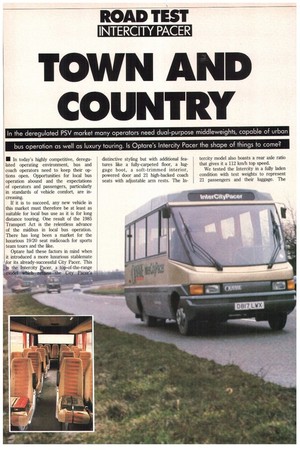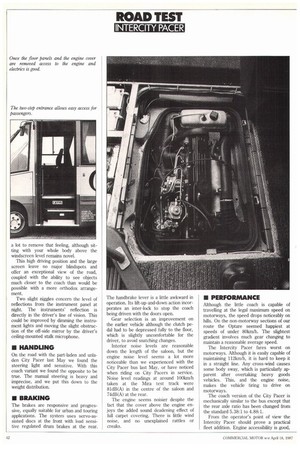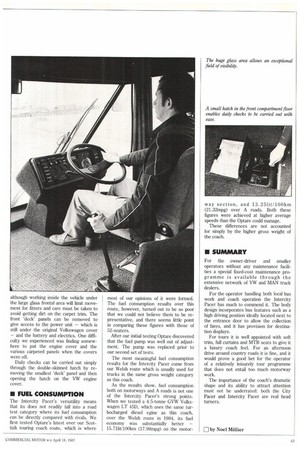TOWN AND COUNTRY
Page 42

Page 43

Page 44

Page 45

If you've noticed an error in this article please click here to report it so we can fix it.
In the deregulated PSV market many operators need dual-purpose middleweights, capable of urban bus operation as well as luxury touring. Is Optare's Intercity Pacer the shape of things to come?
MI In today's highly competitive, deregulated operating environment, bus and coach operators need to keep their options open. Opportunities for local bus operation abound and the expectations of operators and passengers, particularly in standards of vehicle comfort, are increasing.
If it is to succeed, any new vehicle in this market must therefore be at least as suitable for local bus use as it is for long distance touring. One result of the 1985 Transport Act is the relentless advance of the midibus in local bus operation There has long been a market for the luxurious 19/20 seat midicoach for sports team tours and the like.
Optare had these factors in mind when it introduced a more luxurious stablemate for its already-successful City Pacer. This the Intercity rocer, a top-of-the-range model—Ithich the City Pacer's distinctive styling but with additional features like a fully-carpeted floor, a luggage boot, a soft-trimmed interior, powered door and 21 high-backed coach seats with adjustable arm rests. The In tercity model also boasts a rear axle ratio that gives it a 112 km/h top speed.
We tested the Intercity in a fully laden condition with test weights to represent 21 passengers and their luggage. The latest Optare model turns heads in exactly the same way as the City Pacer — during a stop on this test one serious potential buyer approached us.
Its looks are striking, and the quality of its coachwork is exceptional. Even so, at the end of the 1,000km-plus test, we are not convinced about the suitability of the Intercity Pacer for long distance or touring operations.
On the plus side, the high driving position offers superb visibility for both drivers and passengers. On the minus side is an alarming susceptibility to cross-winds at higher motorway speeds. On the plus side is enough interior width and headroom to give passengers the benefit of a big-coach atmosphere. On the minus side is the obtrusive level of engine noise at higher speeds.
The passenger entrance gives easy access. It is behind the front axle and has two steps leading up to the easy-to-clean flat, carpeted floor. The single-leaf, power-operated door is efficient and rattle free, and is fully glazed. A useful feature is that it can be locked by a key, via a lock situated forward of the door on the body side.
Heating is good, with a combustiontype Eberspacher unit taking care of the saloon and the VW demisting system keeping the large windscreen and driver's compartment sidescreen sections clear without any trouble, No forced air ventilation is fitted, but a powerful roofmounted extractor fan and an opening roof vent should keep the interior of the 6.83m coach cool in summer.
The only annoying draught we found was through the bottom of the main entrance door. The driver's signalling window fits well and is both draught and noise free.
Carpeting seems to remove the impression that the vehicle is more like a motor launch than a PSV. On the first City Pacer bus we tried (CM 31 May 1986) the wooden deck sloping towards the bows of the driver's cab definitely had a nautical air. Adding carpet has done
a lot to remove that feeling, although sitting with your whole body above the windscreen level remains novel.
This high driving position and the large screen leave no major blindspots and offer an exceptional view of the road, coupled with the ability to see objects much closer to the coach than would be possible with a more orthodox arrangement.
Two slight niggles concern the level of reflections from the instrument panel at night. The instruments' reflection is directly in the driver's line of vision. This could be improved by dimming the instrument lights and moving the slight obstruction of the off-side mirror by the driver's ceiling-mounted stalk microphone.
• HANDLING
On the road with the part-laden and unladen City Pacer last May we found the steering light and sensitive. With this coach variant we found the opposite to be true. The manual steering is heavy and imprecise, and we put this down to the weight distribution.
• BRAKING
The brakes are responsive and progressive, equally suitable for urban and touring applications. The system uses servo-assisted discs at the front with load sensitive regulated drum brakes at the rear. The handbrake lever is a little awkward in operation. Its lift-up-and-down action incorporates an inter-lock to stop the coach being driven with the doors open.
Gear selection is an improvement on the earlier vehicle although the clutch pedal had to be depressed fully to the floor, which is slightly uncomfortable for the driver, to avoid snatching changes.
Interior noise levels are reasonable down the length of the saloon, but the engine noise level seems a lot more noticeable than we experienced with the City Pacer bus last May, or have noticed when riding on City Pacers in service. Noise level readings at around 100km/h taken at the Mira test track were 81dB(A) in the centre of the saloon and 74dB(A) at the rear.
The engine seems noisier despite the fact that the cover above the engine enjoys the added sound deadening effect of full carpet covering. There is little wind noise, and no unexplained rattles or creaks.
• PERFORMANCE
Although the little coach is capable of travelling at the legal maximum speed on motorways, the speed drops noticeably on hills. On the non-motorway sections of our route the Optare seemed happiest at speeds of under 80km/h. The slightest gradient involves much gear changing to maintain a reasonable average speed.
The Intercity Pacer fares worst on motorways. Although it is easily capable of maintaining 112knilh, it is hard to keep it in a straight line. Any cross-wind causes some body sway, which is particularly apparent after overtaking heavy goods vehicles. This, and the engine noise, makes the vehicle tiring to drive on motorways.
The coach version of the City Pacer is mechanically similar to the bus except that the rear axle ratio has been changed from the standard 5.38:1 to 4.88:1.
From the operator's point of view the Intercity Pacer should prove a practical fleet addition. Engine accessibility is good, although working inside the vehicle under the large glass frontal area will limit movement for fitters and care must be taken to avoid getting dirt on the carpet trim. The front 'deck' panels can be removed to give access to the power unit — which is still under the original Volkswagen cover — and the battery and electrics. One difficulty we experienced was finding somewhere to put the engine cover and the various carpeted panels when the covers were off.
Daily checks can be carried out simply through the double-skinned hatch by removing the smallest 'deck' panel and then opening the hatch on the VW engine cover.
• FUEL CONSUMPTION
The Intercity Pacer's versatility means that its does not readily fall into a road test category where its fuel consumption can be directly compared with rivals. We first tested Optare's latest over our Scottish touring coach route, which is where most of our opinions of it were formed. The fuel consumption results over this route, however, turned out to be so poor that we could not believe them to be representative, and there seems little point in comparing these figures with those of 52-seaters.
After our initial testing Optare discovered that the fuel pump was well out of adjustment. The pump was replaced prior to our second set of tests.
The most meaningful fuel consumption results for the Intercity Pacer come from our Welsh route which is usually used for trucks in the same gross weight category as this coach.
As the results show, fuel consumption both on motorways and A roads is not one of the Intercity Pacer's strong points. When we tested a 4.5-tonne GVW Volkswagen LT 45D, which uses the same turbocharged diesel egine as this coach, over the Welsh route in 1984, its fuel economy was substantially better — 15.71lit/100km (17.98mpg) on the motor way section, and 13. 251it/100km (21.32mpg) over A roads. Both these figures were achieved at higher average speeds than the Optare could manage.
These differences are not accounted for simply by the higher gross weight of the coach.
• SUMMARY
For the owner-driver and smaller operators without any maintenance facilities a special fixed-cost maintenance programme is available through the extensive network of VW and MAN truck dealers.
For the operator handling both local bus work and coach operation the Intercity Pacer has much to commend it. The body design incorporates bus features such as a high driving position ideally located next to the entrance door to allow the collection of fares, and it has provision for destination displays.
For tours it is well appointed with soft trim, full curtains and MTB seats to give it a luxury coach feel. For an afternoon drive around country roads it is fine, and it would prove a good bet for the operator of a relatively leisurely tour programme that does not entail too much motorway work.
The importance of the coach's dramatic shape and its ability to attract attention must not be underrated: both the City Pacer and Intercity Pacer are real head turners.




















































































